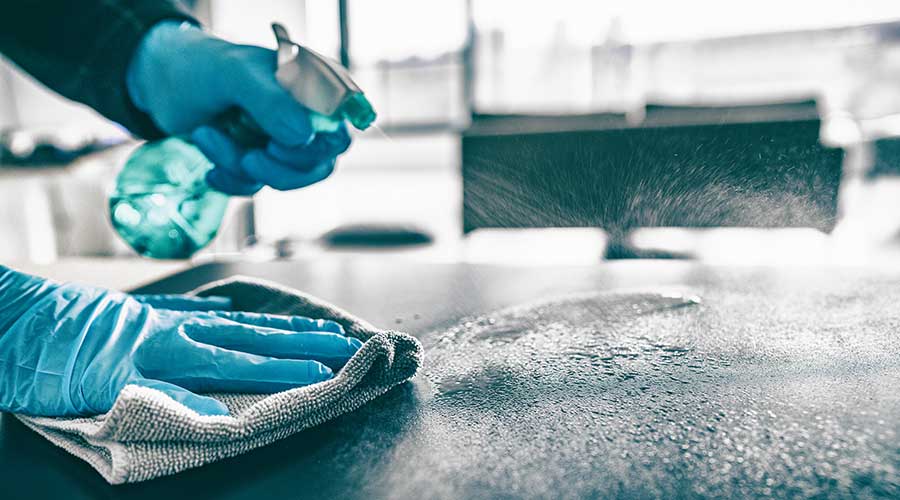The rising prevalence of chronic illnesses, the rising number of surgeries performed in healthcare facilities, the rise in the number of health clubs and gyms and the expanding global tourism industry leads to the market growth of surface disinfectant chemicals.
Additionally, the introduction of cutting-edge disinfection products and growing economies offer tremendous opportunities to the top manufacturers of surface disinfectant chemicals. Many start-ups in surface disinfectant chemicals globally developed a variety of alternatives to conventional chemical-based decontaminants, which can clean surfaces and even micro-cavities, due to the growing risk of disinfectants to humans.
Surface disinfectant chemicals trend analysis shows some of the most current no-touch (automated) decontamination methods. It includes the use of aerosol and vaporized hydrogen peroxide, portable devices that produce continuous ultraviolet (UV-C) light, a pulsed-xenon UV light system and high-intensity narrow-spectrum (405 nanometers) light.
These no-touch techniques have been shown to reduce surface bacterial contamination. The market thus displayed high growth potential, rising from $3.7 billion in 2022 to $5.8 billion by 2033.
The market is majorly driven by rising healthcare costs and heightened consumer cleanliness consciousness. Moreover, the market is expanding due to the rising frequency of numerous infectious disorders like hepatitis, HIV and other hospital-acquired infections.
The adoption of surface disinfectant chemicals is anticipated to grow as people become more aware of different illnesses linked to healthcare. Over the coming years, the industry is also projected to develop as a result of changing lifestyles and an increase in surgeries.
Several disinfectants have the potential to react violently with unrelated substances and release toxic fumes that could threaten workers. All chemical disinfectants have the potential to be dangerous or destructive to living organisms by their very nature. This can harm the overall market share for surface disinfectant chemicals.
Moreover, due to the risk involved with chemical-based disinfectants, consumers are switching to chemical-free alternatives. Human respiratory systems are significantly impacted by chemical-based disinfectants. This adversely impacts the market growth of surface disinfectant chemicals.
For instance, using hand sanitizers excessively may irritate the skin, since they remove the natural oils from the skin and contain chemicals like alcohol, chloroxylenol, chlorhexidine and triclosan.
Based on product type, quaternary ammonium compounds are the leading category, accounting for nearly 43.7 percent of the global market value in 2021.
Quaternary Ammonium Compounds are widely used in the disinfection of healthcare institutions. Growth in the global healthcare industry is expected to aid demand over the forecast period.
Quaternary Ammonium Compounds are expected to remain the preferred choice for many end users. There is a rising focus on point-of-care disinfecting products, which has resulted in the growing sales of surface disinfectant chemicals through 2033.
Commercial and institutional end users are expected to dominate the market over the forecast period, accounting for about 50 percent of the global market share by 2033. The growth registered in this segment can be attributed to the rising demand from the healthcare industry and the development of commercial and institutional infrastructure during the forecast period.
Given the impact of the pandemic, consumers and businesses are increasingly focusing on maintaining workplace hygiene and cleanliness, which is likely to become a mandatory part of business operations, thus driving the market growth.

 UF Health Hospitals Rely on Green Globes to Realize Their Full Potential
UF Health Hospitals Rely on Green Globes to Realize Their Full Potential How Healthcare Facilities Can Be Truly Disaster-Resilient
How Healthcare Facilities Can Be Truly Disaster-Resilient TriasMD Breaks Ground on DISC Surgery Center for San Fernando Valley
TriasMD Breaks Ground on DISC Surgery Center for San Fernando Valley Bigfork Valley Hospital Falls Victim to Data Breach
Bigfork Valley Hospital Falls Victim to Data Breach AI-Driven Facilities: Strategic Planning and Cost Management
AI-Driven Facilities: Strategic Planning and Cost Management